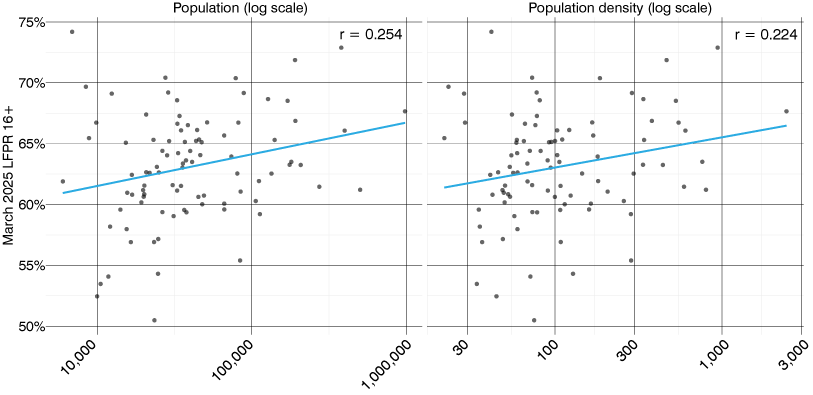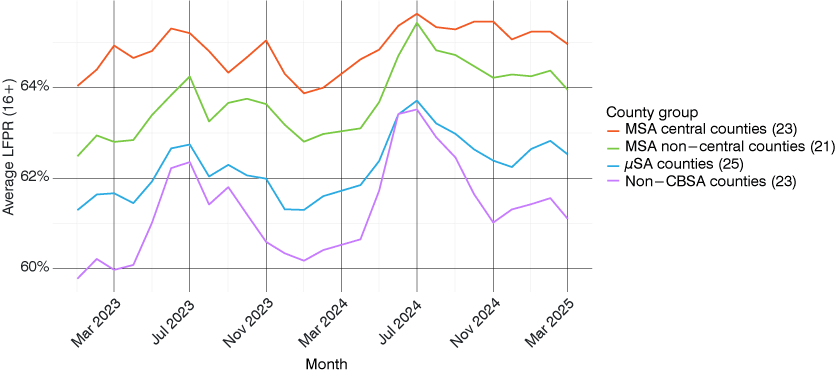Bridging the gap: Urban–rural divides in Indiana’s labor force participation

Indiana’s labor force participation rate has held steady above the national average, but county‐level estimates reveal that this strength is unevenly distributed.
The Indiana Department of Workforce Development estimates and releases employment data monthly, including the number of employed and unemployed workers and the total labor force. From these figures, analysts calculate the labor force participation rate (LFPR), a key metric that measures adult participation in the workforce.
LFPR is the percentage of the civilian noninstitutionalized population age 16 or older (CNP) that is either employed or actively seeking work. The CNP is used instead of the total population age 16 or older because it excludes people who are institutionalized (e.g., in prisons, nursing homes or long-term care facilities) and those on active duty in the armed forces, as these individuals aren’t available to participate in the civilian labor market.
Because it reflects the portion of the population that is attached to the workforce (either employed or actively seeking work), it’s a critical indicator of the economy’s capacity to utilize its labor resources effectively. Greater attachment to the workforce underpins economic expansion, because it both raises production and boosts household purchasing power.
When the LFPR is low or declining, it may signal challenges such as an aging population, discouraged workers leaving the labor market or structural economic shifts. A region with a higher LFPR has greater potential for growth, because more of its workforce is ready to work.
The U.S. Census Bureau American Community Survey (ACS) one- and five-year estimates report LFPRs by age group for states, counties and the nation on an annual basis, though the latest year available is 2023.1 The timeliness, or lack thereof, is a hinderance to understanding real-time developments in the labor force.
So, the Indiana Business Research Center (IBRC) has begun estimating monthly LFPRs by age for Indiana and its counties, leveraging three main sources of data: (1) the ACS, (2) monthly labor force estimates produced by the Bureau of Labor Statistics Local Area Unemployment Statistics (LAUS) program and available on STATS Indiana2 and (3) the Census Current Population Survey (CPS) monthly labor force and population data by age. This article will describe the estimation process, present findings on the regional dynamics of labor force engagement and highlight implications for workforce policy and economic development.
Indiana’s LFPR is consistently higher than the nation’s
Table 1 shows that, across all age groups, Indiana’s LFPR is slightly greater than the nation’s over the past three months (available at the time of this writing). This reflects longstanding economic and cultural patterns favoring a higher-than-average level of workforce participation in the state over the past decade-plus.3
Table 1: Labor force participation rates by age in Indiana and the United States, February through April 2025
| Indiana | ||||
|---|---|---|---|---|
| Month | 16+ | 25 to 44 | 25 to 54 | 25 to 64 |
| Feb-25 | 63.8% | 86.0% | 85.5% | 80.7% |
| Mar-25 | 63.7% | 85.7% | 85.3% | 80.5% |
| Apr-25 | 63.7% | 85.6% | 85.0% | 80.4% |
| United States | ||||
| Month | 16+ | 25 to 44 | 25 to 54 | 25 to 64 |
| Feb-25 | 62.4% | 84.0% | 83.4% | 79.2% |
| Mar-25 | 62.5% | 84.0% | 83.5% | 79.3% |
| Apr-25 | 62.6% | 84.3% | 83.7% | 79.5% |
Source: U.S. Bureau of Labor Statistics, U.S. Census Bureau Current Population Survey and author’s calculations
These economic and cultural patterns include the state’s economic structure and industry mix. Indiana’s economy is heavily oriented toward manufacturing, trade and transportation and warehousing, which tend to have higher levels of workforce engagement than some service sectors.
However, an aging workforce poses risks to the state’s high labor force participation, particularly in these sectors. Workers closest to retirement (ages 55 to 64) comprise 20% of jobs in manufacturing and wholesale trade, compared to 16% for all industries in Indiana, according to Lightcast data.
Even though the state’s labor force participation rate has historically been higher than the nation’s, there’s no assurance it will remain as strong for the next decade-plus. While the state has built-in advantages because of its industry mix, risks and uncertainty abound, and the adage of “past performance does not guarantee future results” rings true here. And as you’ll see, not all parts of the state are performing equally.
LFPR is unequally distributed among Indiana counties
Figure 1 is an interactive dashboard consisting of two components: (1) a map of Indiana showing monthly county-level LFPRs by age that defaults to the most recent month, and (2) a line chart allowing comparison of up to five counties’ LFPR by age to the state rate since January 2023. Click the tabs “Map” and “Line Graph” to switch between the two. Note that clicking “Map Settings” and “Line Graph Settings” won’t switch between the tabs.
Interactive Figure 1: Indiana LFPR dashboard
Source: U.S. Bureau of Labor Statistics, U.S. Census Bureau American Community Survey 2018-2023 5-year estimates, U.S. Census Bureau Current Population Survey and author’s calculations
Though Union County, a small county along the Ohio border, has the highest overall (16+) LFPR in the state at 74.2% as of March 2025 (the latest month available for counties), counties in the Indianapolis metro area generally have the highest rates. This is especially true in Indianapolis’s wealthy northern suburban counties.
Counties in the Fort Wayne, Cincinnati and Louisville metro areas also showed higher LFPRs than the state overall, which was about 63.7% in March 2025.
More rural counties tend to have lower LFPRs across all age groups, though there are exceptions.
Figure 2 plots March 2025 county LFPRs (16+) against 2024 population and population density. Population is log-transformed because there are a few counties with very high populations/densities; the log transformation dampens the influence of these outlier counties.
The correlation coefficient of 0.254 indicates a weak positive linear relationship between LFPR and logged population, while the coefficient of 0.224 between LFPR and logged population density (persons per square mile) similarly indicates a weak positive linear relationship. The story here is that counties with higher population centers have more places to work and thus, higher labor force participation.
Figure 2: Indiana counties' March 2025 LFPR 16+, 2024 population and population density

Source: U.S. Bureau of Labor Statistics, U.S. Census Bureau American Community Survey 2018-2023 5-year estimates, U.S. Census Bureau Current Population Survey, U.S. Census Bureau 2020 Census and author’s calculations
If this is true, metropolitan (MSA) counties would have higher average LFPRs than micropolitan (µSA) and non-CBSA counties.4 Additionally, the central counties of an MSA (meaning they contain all or a substantial amount of the core urban area) would have a higher LFPR than non-central counties, which are the counties within an MSA that don’t have a large urban core but are nonetheless connected to the MSA through commuting patterns and economic ties.
Figure 3 provides evidence for this hypothesis. Central counties of MSAs (most urban) have the highest overall LFPR over the time series, while the non-CBSA counties (most rural) have the lowest. There’s also a clear gap between the MSA counties and the µSA and non-CBSA counties, suggesting that deeper integration into metropolitan labor markets—through greater job diversity, transportation options, support services, etc.—drives higher labor force participation.
Figure 3: Monthly average LFPR 16+ by county’s CBSA status

Source: U.S. Bureau of Labor Statistics, U.S. Census Bureau American Community Survey 2018-2023 5-year estimates, U.S. Office of Management and Budget, U.S. Census Bureau Current Population Survey and author’s calculations
Conclusion
Indiana’s LFPR has held steady above the national average, but county‐level estimates reveal that this strength is unevenly distributed. The most urbanized, central counties of MSAs consistently top the charts, while the most rural counties are lagging. Micropolitan counties fall in between, underscoring a clear urban–rural divide in workforce engagement.
Moreover, the modest positive link between county size and LFPR suggests that population density, and the economic infrastructure it supports, plays a role in drawing more residents into the labor market. These patterns matter because they point to where Indiana’s workforce potential is under‐utilized. Rural counties with persistently low LFPRs may face labor shortages in critical industries, slower economic growth and heightened vulnerability if key employers downsize or close.
By illuminating where and among whom labor force attachment is weak or strong, the county-level, age-specific LFPR estimates equip policymakers, economic developers and community leaders with a level of timeliness and granularity rarely available in standard labor statistics. This sharper, near real-time view can support targeted interventions tailored to the unique needs of each community and age cohort.
Methodological note
County‐level, age‐specific LFPR estimates are calculated by blending three data sources with small‐area adjustments to ensure timeliness and local detail. Monthly labor force counts from the BLS LAUS program are combined with ACS subject table estimates of the civilian noninstitutionalized population 16+ (CNP). When direct CNP estimates are missing, such as for smaller counties and for 2024 (2023 ACS is the latest available), values are imputed by averaging each county’s 2021–2023 CNP-to-population ratio and, if still unavailable, by scaling the state ratio according to each county’s relative 2020 CNP share.
State-level CPS age-group distributions are then applied to disaggregate each county’s overall LFPR into six age brackets. A tuning parameter blends these age-specific rates with the county’s total LFPR to prevent any group from exceeding 100% while preserving local variation. The result is a consistent series of monthly, age-specific LFPR estimates for every Indiana county.
Notes
- U.S. Census Bureau, American Community Survey, table S2301. Accessed at https://data.census.gov/table?q=labor+force+participation+rate&g=040XX00US18$0500000.
- BLS Local Area Unemployment Statistics. Accessed via STATS Indiana at https://www.stats.indiana.edu/topic/laus.asp.
- Hoover, Makinzi, Stephanie Ferguson Melhorn and Isabella Lucy. “Understanding Indiana’s labor market.” U.S. Chamber of Commerce. https://www.uschamber.com/workforce/understanding-indiana-labor-market?state=in.
- As defined by the U.S. Office of Management and Budget, metropolitan statistical areas consist of the county or counties (or equivalent entities) associated with at least one urban area of at least 50,000 population, plus adjacent counties having a high degree of social and economic integration with the core as measured through commuting ties. Micropolitan statistical areas consist of the county or counties (or equivalent entities) associated with at least one urban area of at least 10,000 but less than 50,000 population, plus adjacent counties having a high degree of social and economic integration with the core as measured through commuting ties. Collectively, metropolitan and micropolitan areas are called core-based statistical areas (CBSA). In this context, “non-CBSA” refers to counties that are neither in a metropolitan statistical area nor a micropolitan statistical area.
